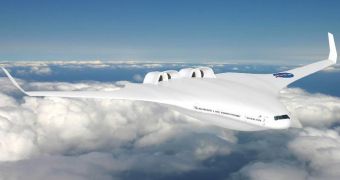The future of the aviation industry is ensured; at least as far as aircraft design goes. Experts with Project NACRE (New Aircraft Concepts Research) present some of the airplanes that may fly within the next few decades.
The research is already fairly advanced, and has produced a number of models already. Experts say that simulations on some of them were already conducted. Some of them show that work can begin on prototypes.
Most models NACRE developed are very interesting to look at from a purely aesthetic perspective. They have unusual designs for aircraft, and even more so considering that some of them are intended for passenger use.
One of the most promising designs is a wide-body aircraft that will be capable of flying over extended ranges, and carry up to 750 passengers at the same time. According to its designers, the machine will have a wing span of 100 meters (333 feet).
It will be 65 meters long from nose to tail, and will reach a height of 19 meters. The aircraft would be able to take off even if it weighs a maximum of 700 tons, Universe Today reports.
This large “flying wing” configuration has already undergone testing at the German Aerospace Center (DLR), and experts here determined that its characteristics make it flight-worth.
The German team is using an advanced combination of hardware and software elements for conducting such studies, aimed at validating airplane concepts. Using ATTAS (Advanced Technologies Testing Aircraft System), DLR can simulate the flight of any aircraft, either existent or non-existent.
On the other hand, Airbus is already considering a new generation of airplanes as well. Its “fantasy plane” would have a tremendously lightweight body, curled wings, and a U-shaped tail. Noise emissions from this aircraft would be significantly below today's, and it could fly by 2030.
Rival manufacturer Boeing is also designing the Icon II aircraft as a response. The 120-passenger aircraft will have a range of around 5,000 nautical miles, and will reach top speeds of Mach 1.8.

 14 DAY TRIAL //
14 DAY TRIAL //